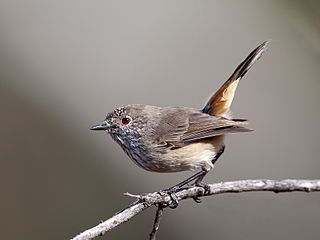
The dibbler is an endangered species of marsupial. It is an inhabitant of the southwest mainland of Western Australia and some offshore islands. It is a member of the order Dasyuromorphia, and the only member of the genus Parantechinus. The dibbler is a small, nocturnal carnivore with speckled fur that is white around the eyes.

The inland thornbill was originally described by English ornithologist John Gould in The Birds of Australia. Inland thornbills are within the order passerines. The inland thornbill belongs to the genus Acanthiza, which now has three more species than the eleven outlined by Gould in The Birds of Australia. The Noongar people of southwestern Western Australia call A. apicalis "Djoobi-Djoolbang". The inland thornbill is also known as the broad-tail thornbill and presently contains several subspecies that were once considered independent species. The word apicalis comes from the Latin for 'tipped'.

Stemonurus apicalis is a species of plant in the Stemonuraceae family. It is endemic to Sri Lanka.
Analyta is a genus of moths of the family Crambidae.
Madaglymbus apicalis is a species of diving beetle. It is part of the genus Madaglymbus in the subfamily Copelatinae of the family Dytiscidae. It was described by Fairmaire in 1898. Madaglymbus apicalis is distributed along the coastlines of much of Africa.

Mimacraea apicalis, the central acraea mimic, is a butterfly in the family Lycaenidae. It is found in Nigeria, Cameroon, Gabon and the Republic of the Congo.

Dindicodes apicalis is a moth of the family Geometridae first described by Frederic Moore in 1888. It is found in Asia, including India and China.
Analyta calligrammalis is a species of moth of the family Crambidae. It is found in Sierra Leone, Ghana, Madagascar, Seychelles as well as in Cameroon, The Gambia, Nigeria, South Africa, and Mali.

Vestalis apicalis, or the black-tipped forest glory, is a species of damselfly belonging to the family Calopterygidae. It is found in India and Sri Lanka.
Chloroclystis analyta is a moth in the family Geometridae. It is found on Sumatra. The species is 23 millimetres (0.91 in) long.

The bluntnose snake eel is an eel in the family Ophichthidae. The author of the species is anonymous, but it has been referred to Edward Turner Bennett in 1830. It is a tropical, marine eel which is known from the Indo-Pacific, including Kenya, Madagascar, South Africa, Taiwan, Thailand, and the Philippines. It dwells at a maximum depth of 22 m, but also frequents shores. Males can reach a maximum total length of 45 cm.

Stegastes apicalis, commonly known as the Australian gregory or yellowtip gregory, is a damselfish of the family Pomacentridae. It is native to the Western Pacific where it occurs on the east coast of Australia, the Great Barrier Reef, Queensland and New South Wales. It has also been reported from Taiwan and Ouvéa Island in the Loyalty Islands.

Philiris apicalis is a species of butterfly of the family Lycaenidae. It is found in New Guinea.
Analyta albicillalis is a moth in the family Crambidae. It was described by Julius Lederer in 1863. It is found in Indonesia and Australia, where it has been recorded Queensland.
Analyta heranicealis is a moth in the family Crambidae. It was described by Francis Walker in 1859. It is found on Borneo.
Analyta nigriflavalis is a moth in the family Crambidae. It was described by George Hampson in 1913. It is found in Nigeria.
Analyta vansomereni is a moth in the family Crambidae. It was described by Willie Horace Thomas Tams in 1932. It is found in Kenya.

Erygia apicalis is a moth of the family Erebidae first described by Achille Guenée in 1852. It is found from the Indo-Australian tropics of India, Sri Lanka to Japan, Australia and the Solomon Islands.
Diadelia apicalis is a species of beetle in the family Cerambycidae. It was described by Gahan in 1890.

Disparoneura apicalis, black-tipped bambootail is a damselfly species in the family Platycnemididae. It is endemic to Western Ghats. It was described from Kodagu, Karnataka, on the upper reaches of the Kaveri River. It is also found to occur in Kuruvadweep, Wayanad, Kerala, along the banks of Kabini River.









